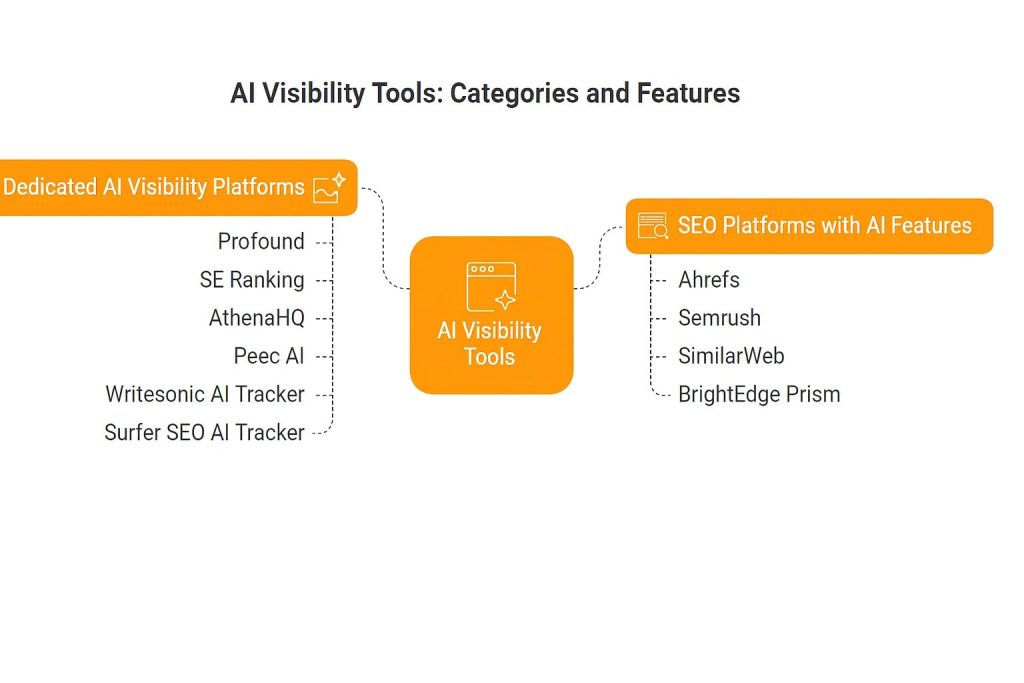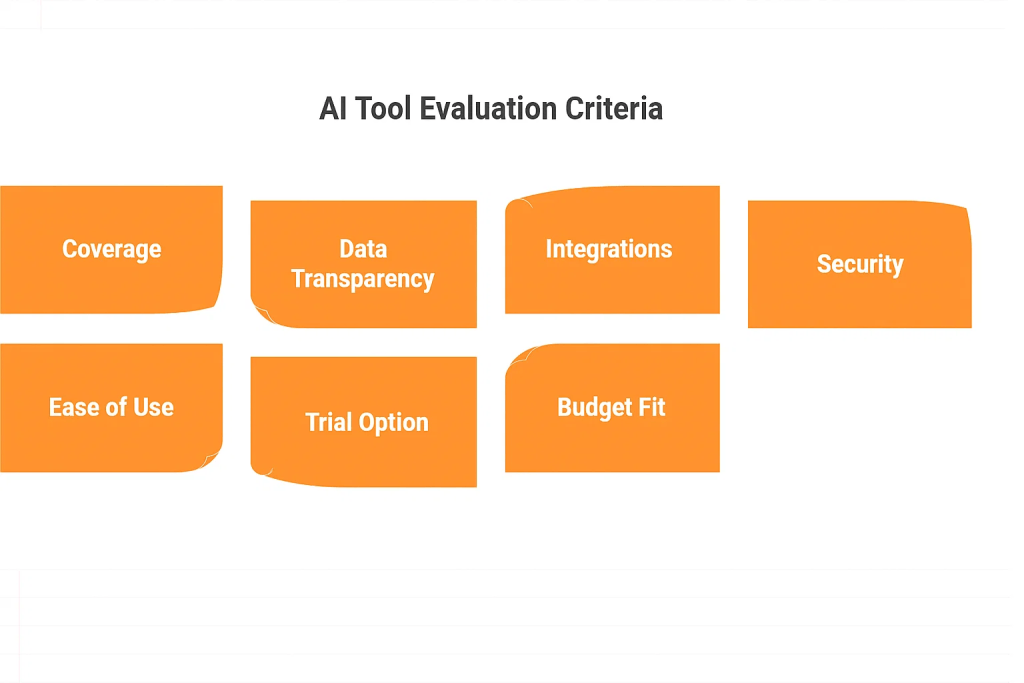AI search is reshaping how people discover information. Tools like ChatGPT, Gemini, Perplexity, Copilot, and Google AI Overviews are giving direct answers that often replace clicks to websites. According to Gartner, organic search traffic is expected to drop by 50% or more by 2028 as users increasingly rely on AI-powered search platforms. If your brand isn’t cited in those AI answers, you’re invisible to a growing share of your audience.
That’s why AI visibility tools are essential. They show you how often your brand appears in AI responses, what prompts trigger mentions, and whether competitors are taking more share of voice.
Quick Takeaways
- AI visibility tools track brand mentions, citations, share of voice, and sentiment inside AI responses.
- They monitor platforms like ChatGPT, Google AI Overviews, Gemini, Perplexity, Claude, and Copilot.
- The best tools give you real-time snapshots, prompt-level insights, and competitor benchmarks.
- AI visibility tracking is becoming as important as traditional SEO.
Read our latest guide on SEO localization.
What Are AI Visibility Tools?
An AI visibility tool is software that tracks how your brand shows up in answers generated by large language models (LLMs) like ChatGPT, Perplexity, or Google AI Overviews.
Think of it as the AI-era version of SEO rank tracking. Instead of checking if your page ranks #1 On Google, you check whether AI tools mention your brand, cite your site, and describe you accurately.
Here are the main metrics these tools deliver:
- Mentions and citations → When your brand is named in an AI-generated response, and whether it links back to your site.
- Share of voice → The percentage of AI answers that mention you compared to competitors in your industry.
- Sentiment → Whether the AI describes you in a positive, neutral, or negative way. This helps spot reputation risks.
- Prompt triggers → The types of questions or prompts that cause your brand to appear. For example, “best CRM for small business” or “top sneakers for running.”
- Source links → Whether the AI pulls information directly from your site or from other sources (like a competitor or third-party article).
Most AI visibility platforms cover the major engines, including:
- ChatGPT (OpenAI)
- Perplexity AI
- Claude (Anthropic)
- Google Gemini
- Microsoft Copilot
- Google AI Overviews (AI search snippets)
In short: if SEO tells you how you perform in search, AI visibility tools tell you how you perform in AI answers.
Why AI visibility Matters?
AI is reshaping how people search for information. Traditional SEO still matters, but user behavior is shifting fast:
AI is eating search: Perplexity hit 10 million monthly active users in under a year, and ChatGPT now serves 100M+ weekly users. That’s traffic that may never touch Google.
Zero-click reality: A 2024 SparkToro study found that over 60% of AI-generated answers give no direct website click. The AI output itself becomes the final stop, meaning if your brand isn’t in the answer, you’re invisible.
Competitive edge: If your competitor’s name appears more often in AI answers, they effectively control the narrative in your industry. That influence compounds over time.
Optimization insight: Visibility tracking reveals which topics, formats, and sources AI prefers. For example, maybe AI consistently cites comparison tables or industry benchmarks. That’s a signal you can use to shape future content.
Accuracy and reputation: AI sometimes makes factual mistakes. If it misstates your pricing or product details, you want to know quickly. Visibility tracking alerts you so you can correct the record.
Without visibility tracking, you’re flying blind. You don’t know how AI represents you, whether your competitors are winning, or if customers are being fed outdated information.
Real-world Use Cases
AI visibility tools aren’t just for vanity metrics. They give businesses data they can act on. Here’s how teams are using them today:
Audit Brand Presence in AI Answers
See how often your brand shows up in ChatGPT, Perplexity, Gemini, and Google AI Overviews. This is the AI equivalent of checking your keyword rankings in Google.
Check the Accuracy of the Facts AI Says About You
AI often pulls outdated or incorrect details. With visibility tracking, you can catch when models get your pricing, features, or company background wrong, and move quickly to correct it.
Benchmark Competitors
Know how often your competitors are cited compared to you. If they appear more frequently, you’ll see where you’re falling behind and what kinds of prompts favor them.
Find Content Gaps
Visibility data shows the types of questions that surface your competitors but not you. This reveals new opportunities, topics, formats, or resources you should create to win mentions.
Protect Brand Reputation
If an AI response frames your business negatively, or confuses you with another brand, you’ll spot it immediately. This is crucial in industries where trust is everything.
Support Content Strategy
By analyzing prompt triggers, you learn what formats AI prefers, FAQs, case studies, comparisons, statistics. That feedback helps shape your future content so it gets picked up more often.
Improve Reporting to Stakeholders
Marketing teams use AI visibility reports to show leadership where the brand stands in the AI search landscape, much like SEO dashboards show Google rankings.
Categories of AI Visibility Tools

There are two main types of tools in this space. Each serves a different need depending on your budget, team size, and workflow.
1. SEO Platforms with AI Visibility Features
These are the big SEO suites you may already know, now updated with AI search tracking. Instead of building from scratch, they’ve bolted AI visibility onto their existing rank tracking and analytics tools.
Examples:
- Ahrefs – Testing AI Overviews mentions so marketers can see when their pages are cited in Google’s AI answers.
- Semrush – Rolling out an experimental module to track AI search visibility alongside traditional keyword rankings.
- SimilarWeb – Using its traffic intelligence engine to estimate traffic impact from AI-driven search.
- BrightEdge Prism – Offers AI visibility as an add-on, tied to its enterprise SEO reporting.
Why choose this type:
- Familiar dashboards if you already use the platform.
- Easier to integrate into existing SEO workflows.
- Usually includes broader SEO data (rankings, backlinks, traffic).
Limitations:
- AI coverage may be limited or still in beta.
- Data refresh rates can lag compared to purpose-built platforms.
2. Dedicated AI Visibility Platforms
These are built specifically for AI search and LLM monitoring. They don’t try to be all-in-one SEO tools, they focus only on tracking brand presence inside AI answers.
Examples:
- Profound – Enterprise-focused, full coverage across ChatGPT, Perplexity, Gemini, Copilot, and more.
- SE Ranking (AI Visibility) – Adds a specialized AI module to its platform, bridging SEO + AI.
- AthenaHQ – Designed for SMBs and content teams, with prompt-level data and recommendations.
- Peec AI – Affordable entry-level option for testing AI visibility.
- Writesonic AI Tracker – Tracks mentions and sentiment across AI platforms, marketed as “Ahrefs for AI.”
- Surfer SEO AI Tracker – Integrates AI visibility into content optimization workflows.
Why choose this type:
- Built for real-time AI visibility tracking.
- Usually provide more granular data (prompt triggers, sentiment analysis, screenshots).
- Better suited for teams prioritizing AI presence over traditional SEO.
Limitations:
- May require running alongside your SEO tool (extra platform to manage).
- Some are still new and evolving quickly, so features can change.
Best AI Visibility Tools
Here’s a side-by-side look at some of the top players.
| Tool | Supported AI platforms* | Trial / Demo | Pricing | Best for |
| Profound | ChatGPT, Gemini, Perplexity, Copilot, Claude, Google AI Overviews | Demo available | Enterprise pricing | Large teams, compliance-heavy sectors |
| SE Ranking (AI Visibility) | ChatGPT, Google AI Overviews, Gemini, Claude | Free trial | Mid-range | Marketing teams, SEO managers |
| AthenaHQ | ChatGPT, Perplexity, Gemini, Claude | Trial | SMB-friendly | Content and editorial teams |
| Peec AI | ChatGPT, Claude, Perplexity | Trial | ~€89/month | Budget-conscious teams |
| Writesonic AI Tracker | ChatGPT, Perplexity, Claude, Google AI Overviews | Free tier | Affordable plans | Agencies and freelancers |
| Surfer SEO AI Tracker | ChatGPT, Gemini, Claude | Demo | Add-on plan | SEO professionals |
*Based on documentation as of 2025; platforms are expanding coverage rapidly.
Mini-Reviews
Profound – best for enterprise
Covers the widest range of platforms, provides screenshots of AI outputs, integrates GA4, and offers SOC 2 Type II compliance. Ideal for industries like finance, healthcare, or global corporations.
SE Ranking (AI Visibility) – best for marketers
Balances affordability and features. Tracks mentions across ChatGPT and Google AI Overviews, plus integrates with SEO workflows.
AthenaHQ – best for SMBs
Focuses on ease of use with prompt-level data and recommendations. Great for content teams that need practical guidance.
Peec AI – best entry-level option
Budget tool that still delivers mention tracking and competitor comparisons. A low-risk way to start measuring AI presence.
Writesonic AI Tracker – best for agencies
Built for reporting. Provides sentiment tracking and “share of voice” metrics that agencies can present to clients.
Surfer SEO AI Tracker – best for SEOs
Adds AI visibility into existing SEO campaigns, making it easier to connect keyword ranking data with AI presence.
How to Choose the Right AI Visibility Tool

When comparing platforms, check for:
- Coverage: Does it track ChatGPT, Gemini, Perplexity, Claude, Copilot, and Google AI Overviews?
- Data transparency: Does it explain how data is collected—via API or simulated prompts?
- Integrations: Can it connect to GA4, GSC, or CRM dashboards?
- Security: Look for SOC 2, GDPR compliance if you work in regulated industries.
- Ease of use: Dashboards should be simple enough for teams to actually adopt.
- Trial option: Run a demo to confirm the tool’s data reflects your brand’s reality.
- Budget fit: Some tools are €89/month; others are enterprise-only. Choose what matches your needs.
Limitations You Should Know
AI visibility tools are valuable, but they’re not perfect. Here are the main limitations to keep in mind:
AI Responses Change Constantly
Large language models are updated frequently, and their answers can vary day to day. A prompt that shows your brand today might not mention it tomorrow. That means visibility tracking should be seen as a trend over time, not a single fixed result.
Tools Can Only Track What They Simulate
Most platforms work by sending synthetic prompts into AI systems. They can’t predict every question real users ask, so they may miss niche or unusual prompts. Coverage is strong for common queries, but less reliable for rare edge cases.
Not all LLMs Allow Deep API Access
Some AI engines (like Gemini or Claude) don’t offer open APIs for tracking. Tools may rely on scraping or workarounds, which means data accuracy and stability can vary. Always check how your provider collects results before relying on their reports.
Share of Voice Metrics Are Still Early
“Share of voice” in AI search is useful for comparing you with competitors, but it’s not absolute. It’s based on the prompts the tool runs, not the entire universe of user queries. Treat it as a directional signal rather than a hard number.
Risk of Incorrect AI Data
Even when your brand is mentioned, the AI might describe you inaccurately, wrong pricing, outdated services, or mixed-up details. Tools can help flag this, but fixing the underlying problem may require publishing clearer content or outreach to the provider.
Conclusion
AI search is here. It’s fast, growing, and already influencing user decisions.
If you want to:
- Know when AI talks about you
- Fix wrong or outdated info
- Spot missed opportunities
- Keep up with competitors
Then you need an AI visibility tool.
Start with:
- Profound if you’re enterprise or regulated
- SE Ranking if you’re a marketer
- Peec AI if you’re testing with a small budget
Track. Compare. Improve. And don’t guess where your brand stands in AI anymore.
FAQs
What features actually matter in an AI visibility tool?
The features that matter in an AI visibility tool are LLM coverage (ChatGPT, Gemini, Perplexity, Claude, Copilot, Google AI Overviews), citation and prompt tracking, competitor benchmarking, sentiment analysis, and integrations with tools like GA4.
What are the hidden factors no one tells you about when choosing AI visibility tools?
The hidden factors in choosing AI visibility tools include data freshness, the method of collection (API vs scraping), accuracy of coverage claims, export limitations, and whether pricing hides advanced features.
Do AI visibility tools meet security and compliance standards like SSO or SOC-2?
AI visibility tools may or may not meet standards like SSO and SOC-2. Enterprise platforms usually support SOC-2, SSO, and GDPR compliance, while smaller or budget tools often don’t.
Who owns the data these tools collect? Can I export it?
The data collected by AI visibility tools should remain with you, but export options vary. Some platforms allow CSV or BI exports, while others restrict you to in-platform dashboards.
What does an AI Brand Visibility Tracker actually do?
An AI Brand Visibility Tracker monitors your brand in AI-generated answers, shows the sources AI cites, and compares how often you appear against competitors across major LLMs.
Why is the Brand Visibility Tracker valuable for your AI strategy?
The Brand Visibility Tracker is valuable because it highlights missed mentions, flags inaccuracies, and shows competitor presence. This insight helps you refine content and protect reputation in AI search.






